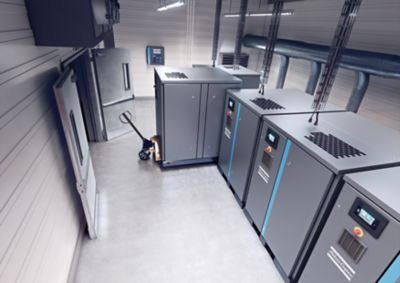Why compressed air leak detection matters – and how to maximise its benefits
Neil Frater, Technical Support Engineer AIRScan, Atlas Copco Compressors UK
Manufacturing businesses seeking to reduce production costs and improve energy efficiency may well benefit from reviewing their compressed air system. Conservative analyses estimate that such systems account for 10 percent of all energy used in global industry, and of that,10 – 30 percent is wasted on leaks. This wastage can be very expensive, as even a 3mm leak could cost around £2000 a year, with an energy loss equivalent to 16 tonnes of CO2 emission.
Nevertheless, compressed air energy audits are not as ubiquitous as they could be. Some users are simply not aware of the extent of any onsite leakage, or the associated cost; others are concerned that any audit will be disruptive and time-consuming. Yet, when done correctly, auditing can be efficient, fast and hassle-free, while highlighting opportunities for energy-saving and process improvements.
In fact, initial steps can be taken that involve little or no technology. Firstly, a compressor can be run without attached equipment operating, to minimise background noise. Some leaks can then be found simply by listening, although larger ones may be inaudible, or only occur at certain pressures. Others may be inaccessible.
Results can be somewhat improved by applying a soapy water solution to potential leak points like joints, flanges and valves with a spray or soft brush; bubbling will indicate any leaks. However, the method is very time-consuming, and still relies on good access to all pipework.
The best, and most widely-used, approach is to use ultrasonic detection equipment. It operates without interrupting plant operation, reaches system areas that are hard to access, and locates all leaks.
The principle behind ultrasonic air leak detection is simple. As air moves from high pressure to low pressure through a leak site, it creates a turbulent flow. This turbulence has strong ultrasonic components which are detectable. In general, the larger the leak, the greater the ultrasound level. Ultrasonic detectors are usually unaffected by background noises in the audible range because these are filtered out. Accordingly, leaks can be heard in even the noisiest environments.
Various hand-held, battery-operated probe devices are available, which can be aimed at the pipework under investigation. One type electronically converts the high-frequency emissions into lower-frequency equivalents audible through a headset. Another is designed as a camera which shows images of the surveyed pipework, with any detected leaks appearing as bright dots.
These ultrasonic instruments’ money-saving benefits are maximised when they are used within an ongoing compressed-air system monitoring strategy. This presents survey results to management in a clearly-understood, actionable format; also, the survey can be repeated at regular intervals - typically every six months or so - to catch new leaks as they appear.
Atlas Copco performs ultrasonic leak surveys as part of their AIRScan energy audit service, which checks flow, power and air quality, and assesses maintenance levels, as well as leaks. Each survey report includes ID photographs where applicable, CFM leak rates in colour-coded schedules, associated costs, and equivalent CO2 emission losses.
Such surveys can facilitate many benefits, including:
· Continuous energy cost reduction
· Increased air compressor and treatment equipment life through load reduction, reducing cost of ownership.
· Productivity improvements from maintaining higher system pressures.
· Compliance with legislation when incorporated with other regulations.
A typical AIRScan can lead to 25-30% energy savings. For example, in one recent Atlas Copco project, a leakage detection programme instigated across a UK vehicle manufacturing plant identified leaks costing £102,000 a year in lost energy. A similar programme, conducted over three days by Atlas Copco’s AIRScan team at the site of a UK-based food manufacturer, pinpointed £49,000 worth of leaks. This illustrates the benefit of conducting this type of audit. However, if the AIRScan engineers don’t find leaks to cover the cost of the survey, there’s no charge.
In January 2021 we held a webinar entitled: Which compressed air audit is right for your production facility?
On average 20-40% of compressed air produced is lost to leaks. Let us show you how to reduce this!
This webinar looks at why most compressed air systems have leaks, explain the different air audits and leak detection possibilities, and help you discover which one is right for your production facility.
Complete this form to watch this webinar on demand

